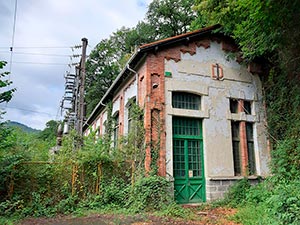Hydroelectric power plants in the Bidasoa basin
Oronoz Central
The Oronoz power plant is easily accessible via a track that starts at the bridge of the old N-121 B over the Bidasoa river, which is called Baztan in its course through this valley. The catchment is located four kilometers upstream, in the town of Arraioz, hence the name Electra Arráyoz-Oronoz when it came into operation in 1916.
This power plant was promoted by the Sociedad Múgica, Arellano y Cía., whose main activity was the import and manufacture of agricultural machinery, with branches all over Spain, but which was also dedicated to the electrical business. It was a business controlled by engineers -Daniel Múgica Gortari and Cornelio Arellano Lapuerta-, which was first used in the execution of hydroelectric works -the Zudaire plant for Cementos Portland or the Olaldea plant for La Papelera Española- and later became a producer with the Arráyoz-Oronoz waterfall and the Urroz and Oiz plants, regulated by the Leurza reservoirs.
The powerhouse of the Oronoz power plant has a symmetrical and orderly composition, with a marked horizontality, as can be seen in the facade facing the river -nowadays hidden by vegetation-, where there are seven large windows. In it, the protagonism of the brick stands out, which articulates the wall forming pilasters with recesses and finishes it off at the top with several courses supported by a decreasing profile . The outline is repeated on the short side, but in this case in a staggered manner to adapt to the gable roof. The result is an interesting chromatic game in which the red brick, the white mural finish, the green woodwork of the door and the windows, and the grayish ashlars of the plinth alternate. The interior is equipped with two groups and preserves the original pavement of starry design tiles. This building, which must be considered one of the most significant of Navarre's hydroelectric heritage, is currently in a worrying state of disrepair withdrawal.
ALEGRÍA SUESCUN, D., "El molino harinero de Zubieta. Evolución histórica", in Notebooks of ethnology and ethnography of Navarren.º 82 (2007), pp. 5-15.
APEZTEGUÍA ELSO, M. and IRIGARAY SOTO, S., "El Ecomuseo del Molino de Zubieta (Navarra): experiencia pionera en la recuperación y musealización de una instalación preindustrial", in Museum: Magazine of the association Profesional de Museólogos de España (Professional Association of Museologists of Spain)No. 4 (1999), pp. 181-192.
BERAZALUCE ELCARTE, M., "La industria hidro-eléctrica en Navarra", in Rafael Guerra (ed.), Navarra. Ayer, hoy y mañana, Pamplona, Diputación Foral de Navarra, 1933.
HERREROS LOPETEGUI, S. (coord.), Centrales Hidroeléctricas en Navarra (1898-2018), Pamplona, Gobierno de Navarra, 2020.
Map of status based on El agua en Navarra, Pamplona, Caja de Ahorros de Navarra, 1991.











